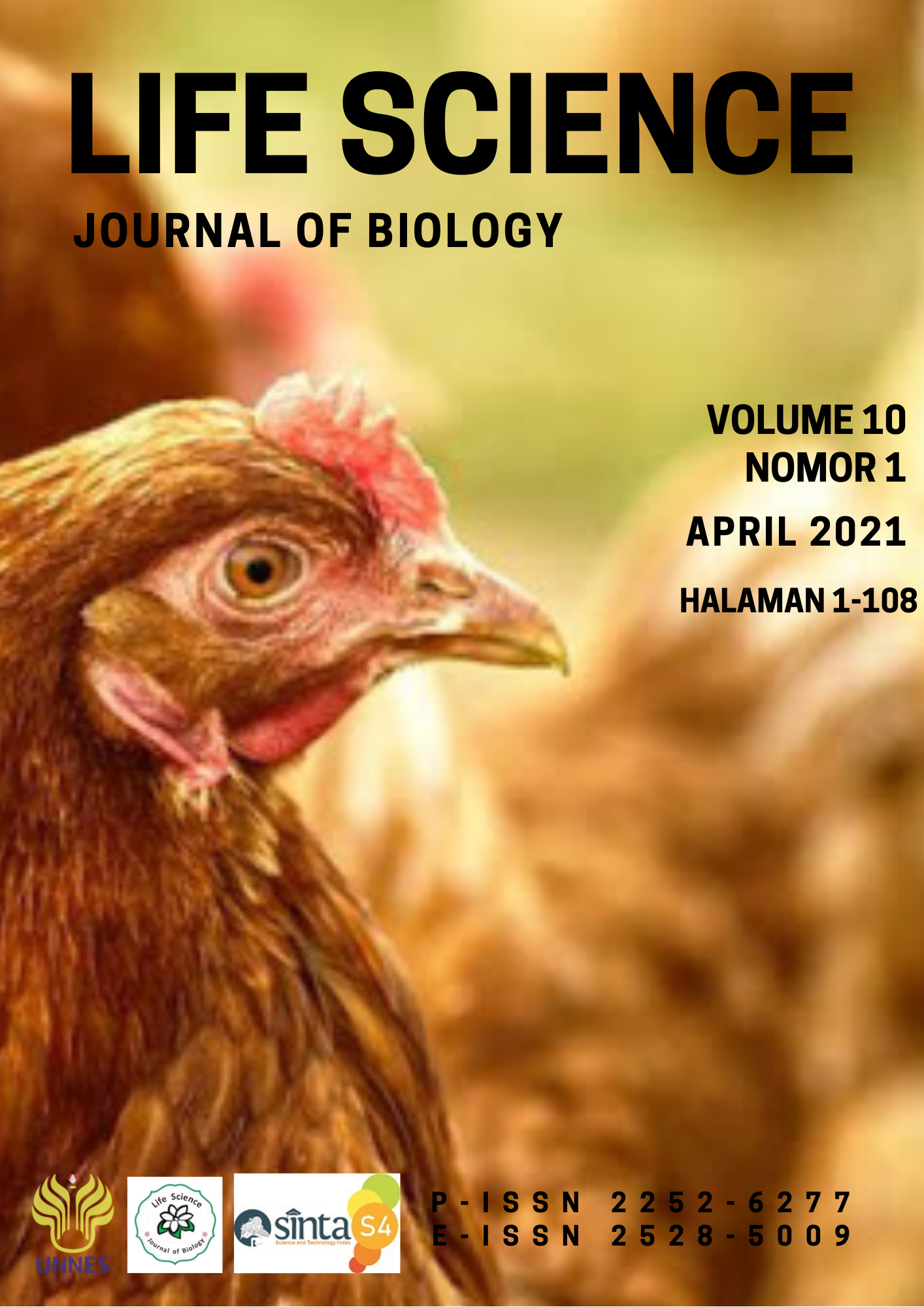Bioaplikasi Kitosan dan Vitamin C terhadap Kadar Hemoglobin Rattus norvegicus yang Dipapar Pb Asetat
Main Article Content
Abstract
Akumulasi Pb2+ dalam darah dapat menghambat kerja enzim-enzim pensintesis hemoglobin (Hb). Penelitian ini dilakukan untuk menganalisis apakah kombinasi kitosan dan vitamin C akan saling bersinergi mengurangi dampak negatif Pb2+ dalam tubuh, terutama terhadap kadar Hb. Penelitian ini mnggunakan Post Test Control Group Design. Populasi penelitian adalah tikus jantan galur Wistar 30 ekor yang terbagi dalam enam kelompok perlakuan, yaitu kelompok kontrol (KK) diberi makan dan minum ad libitum, kontrol negatif (KN) hanya diberi Pb asetat 175 mg/kg BB, kontrol positif (KP) diberi Pb asetat 175 + kitosan 64 mg/kg BB, dan kelompok perlakuan (P1, P2, P3) dipapar Pb asetat, kitosan, dan vitamin C dosis 100, 200, dan 300 mg/kg BB. Perlakuan dilakukan selama 42 hari. Darah tikus diambil pada hari ke-44 untuk diuji kadar Pb darahnya menggunakan metode Atomic Absorbsion Spectrofotometer (AAS) dan kadar Hb dengan metode Cyanmethemoglobin. Hasil uji Anava menunjukkan terdapat penurunan kadar Pb darah dan kenaikan kadar Hb darah secara signifikan pada kelompok yang dipapar Pb asetat dan diberikan kitosan dan vitamin C. Hasil uji lanjut dengan Duncan Multiple Range Test (DMRT) menunjukkan bahwa kelompok KK, KP, P1, P2, P3 tidak berbeda secara signifikan, namun bebeda signifikan terhadap kelompok KN. Simpulan penelitian ini adalah kombinasi kitosan dan vitamin C saling bersinergi menurunkan kadar Pb darah tikus dan meningkatkan kadar Hb darah tikus yang dipapar Pb asetat.
Keywords: Chitosan; Pb acetate; blood Pb levels; blood Hb levels; Vitamine C, Kitosan; Pb asetat; tingkat Pb darah; tingkat Hb darah; Vitamin C.
Accumulation of Pb2+ in the blood inhibits various enzymes involved in heme synthesis pathway. This study aims to analyze the synergy potential of chitosan and vitamine C combination in depleting the detrimental effects exerted by Pb2+ exposure in the body, especially to blood Hb levels. This study use Post Test Control Group Design. The population of the study is male Wistar rats and a number of collected samples are 30 samples. The sample were divided into six group, the regular control (KK), that was fed and water ad libitum, the negative control (KN) was administrated only with Pb acetate at dose 175 mg/kg BB, positive control (KP) was administrated with Pb acetate + chitosan 64 mg/kg BB, and treatment group (P1, P2, P3) that was exposed by Pb acetate 175 mg/kg BB, chitosan 64 mg/kg BB, and vitamine C at dose of 100, 200, and 300 mg/kg BB. The treatment were administrated for 42 days. Blood was then collected on the 44th day to measure blood Pb level using Atomic Absorbsion Spectrofotometer (AAS) method, and to measure blood Hb using Cyanmethemoglobin method. The results of one way Anava showed a significant decrease in blood Pb level and increase in blood Hb level on groups exposed to Pb acetate and treated with combination of chitosan and vitamine C. The results of Duncan Multiple Range Test (DMRT) showed that group of KK, KP, P1, P2, and P3 were not significantly different to one another, but significantly different to the KN group. The conclusion of this study is combination of chitosan and vitamine C is synergy to decrease further blood Pb level and and increase blood Hb level in rats exposed with Pb acetate.
Keywords: Chitosan; Pb acetate; blood Pb levels; blood Hb levels; Vitamine C, Kitosan; Pb asetat; tingkat Pb darah; tingkat Hb darah; Vitamin C.
Article Details

This work is licensed under a Creative Commons Attribution 3.0 License.

